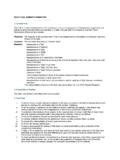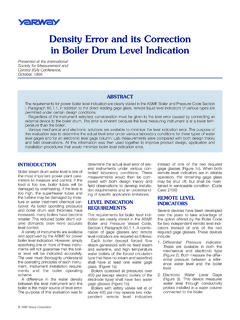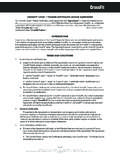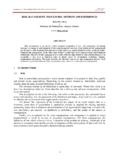Transcription of How to create a multi-level house in Sweet Home 3D
1 How to create a multi -level housein Sweet Home 3DA guide for users who want to design a house with more than one floor, or who want explore the full potential of Sweet Home 3D . Hans Dirkseversion - January 12, 2010 for SH3D - February 2012 for SH3D + plug-ins1 NoteWith Sweet Home 3D version a new feature was added: Plan Add level . This allows you to create a multi level design directly within the means you do not need to follow this tutorial to create a multi level design, although the procedures described in this tutorial can be ueful in special situations. 2 How to create a multi level house in Sweet Home 3 DMany people on the S weet H ome 3D forum ask questions about layers, split level homes, second floors, roofs etc. The answer is no, no and no. None of these is possible in the current version of SH3D (version ). Nevertheless, there are workarounds that make it possible to create many homes that seem impossible to make.
2 Click here and here to see pictures of some of this guideThis guide discusses: how you can build a part of an object (in this case a house ) how you can export that part as an OBJ file how you can import it as a furniture element how you can assemble these elements into a complex object, that could not have been constructed using the standard tools available in Sweet Home 3D version guide assumes that you have the CopyAsNewFurniture plug in, as well as the AdvancedEdit plug in installed. See the plug in tutorial on how to install and use these plug 'll discuss the first of the two examples and show how I solved some of the construction problems. The entire house consists of five blocks: the ground floor plus the four OBJ blocksLayer 0 the front part of the first floor *Layer L1a the rear part of the first floor*Layer L1b the front part of the roof *Layer L2a the rear part of the roof *Layer L2b * This file is exported as an OBJ file and used in Layer 0 Click on the links to download the 0 shows the details of the ground floor and everything that is beneath the floor texture of the first floor; in this file, four OBJ files have been imported that form the rest of the house ; to see all the details, you should inspect the other files as well;Layer L1a shows the details of the rectangle that forms the front of the house on the first floor; it has been exported as an OBJ file and used in Layer 0.
3 You can use this file to see how it's L1b shows the details of the rectangle that forms the back of the house on the first floor; it has been exported as an OBJ file and used in Layer 0; you can use this file to see how it's L2a shows the details of the rectangle that forms the front part of the roof; it has been exported as an OBJ file and used in Layer 0; you can use this file to see how it's L2b shows the details of the rectangle that forms the back part of the roof; it has been exported as an OBJ file and used in Layer 0; you can use this file to see how it's import an OBJ file use Furniture Import Why five blocks?A cutting up verticallyIf you have a relatively simple design, you could insert a box that functions as ceiling and floor, and put all furniture on top of the box. But if you want to make something more complex, you'll soon find that it's not a really good , a better solution would be to design each floor as a separate project and then stack them to build, or assemble, your house .
4 In this way your house can have as many floor as you like, as long as you don't go higher than 24,999 meters. A problem you encounter when you export your floor as an OBJ is that SH3D automatically inserts a floor even if you didn't draw it. As long as you draw perfectly rectangular floors, this isn't a problem, but every deviation from the rectangle will show up as a zero thickness white floor that surrounds part of your design to make it , when you use CopyAsNewFurniture, this false floor isn't generated, and you can copy and insert a clean , when you start to design your project, you first have to decide how to cut up your model in rectangular building blocks that you can stack without seeing the seams after cutting up horizontallyWhen deciding about the horizontal sections of your project there are a few things you have to bear in mind: Textures on floors Textures adhere always to floors, so for every level on which you want a texture, you will have to create a new horizontal section.
5 Textures on walls You can't stack textures on a wall. So if you want the lower part of a wall to have a different texture or color than the upper part, you will have to create that wall in two horizontal sections. Another way to achieve this, is making a special texture, as explained in this guide ). Ceilings work fine when all walls of a room have the same height. In the current version, ceilings work more or less fine when two opposite walls have the same slope (as demonstrated here and here). Ceilings don't work very well in most other cases, so you will have to invent your own solutions. 4 Drawing the general floor planFirst we start by drawing the basic floor plan. I call it L0 (as in: layer zero) and use it as a reference file, I draw all the walls in it, the outline for terraces and/or patios and everything else that I will need. It is very important that you do this very carefully, because all sections of the house will use this file as a template.
6 You can't make changes to walls later on, because then things will not line up correctly when you do the final assembling of your house . See picture : Correcting corners & compensating wall thicknessWhen you draw walls in SH3D, the program will auto connect the corners as long as you keep drawing the walls in a continuous way. If you want that the last wall connects with the first wall of that series, you have to double click carefully on the end of the first wall (the first wall gets selected during the drawing to show you it will be connected to the current wall). If the last wall isn't connected to the first wall, or if you can't connect a wall to an other one (for example because the end of that wall is already connected to an other wall), this produces a jagged corner. If you want your renderings to show perfectly smooth corners, without the jagged edges, you will have to manually correct the length of the first and/or last wall.
7 The best way to do so, is to use the function Plan Connect walls of the AdvancedEdit plug find that the only way to make a good drawing is entering the exact X,Y coordinates by hand. This can be achieved directly by entering the length and angle of each wall during the drawing of walls (by pressing the Enter key), or manually by correcting the coordinates after drawing the wall(s).5 Illustration 1: Layer 0 Drawing the ground floor levelOpen Layer 0 and save it as Layer 1. On this layer we will show everything that is underneath the texture of the first floor. Because it's a raised house , here you will put the foundation, the ground textures, etc. See picture layer contains nine rooms. three grass rooms five pavement rooms one gravel roomAll rooms were drawn by hand. SH3D provides several magnetic aides to help you position the cursor. When the cursor lines up with a wall you can see a small line when it lines up with the center or side of a wall, or you may see a long line when it lines up with a point further away When the cursor lines up with a corner or intersection you will see a cross hair, or you may see a purplish dot around the cursor.
8 Make sure rooms don't overlap, because this will cause strange glitches from the render engine. So, after making a rough first draught, zoom in and carefully check every line and 2: Layer 1 Tip: perfect roomsTo make perfectly fitting rooms, you may use Plan Edit room points of the plug in AdvancedEdit. See the plug in manual to learn how to install and use : better illuminationThe reason that there are four gravel rooms under the building is to add light in the rendering. When you make a photo (3D view create ) the two highest quality settings will take into account one light in every room. For a large room, the light will be stronger, but it may still result in dark corners and unnatural shading. Divide the room in several smaller rooms and each section will have a light source at its center. Note that this only works when Display ceiling is checked. See picture 3. 7 Illustration 3: Display ceiling is a light switch Drawing the first floorTo draw the first raised floor, load the Layer 0 file again.
9 Because the first floor will consist of two blocks, you will need to save the file twice, as Layer 1a and as Layer the file Layer 1a delete all features in the right part of your design. Repeat the process using the file Layer 1b, where you delete all features on the left part of your design. See picture 5 and : orientation of texturesSH3D doesn't have an option to rotate textures. A workaround would be to import a texture twice, with the second texture rotated 90 4: False floor in exported OBJ 9 Illustration 5: Layer 1a Illustration 6: Layer 1bWe now have the basic building blocks of the first floor of our house . It's time to add some invisible wall openingWalls always start on the floor. That seems obvious, but sometimes you want your wall to start above the ground level. For this (any many other things) we use the invisible wall opening. You can download the file here. Basically this object resembles the service hatch, but its walls are thinner and it's made invisible through manipulating the MTL file.
10 The last line (d ) does the trick:newmtl piece_1_piece_a_1_1illum 9Ka 7: Invisible wall opening to raise a wallIf you look at the illustration above, you will see that there's a gap beneath the wall at left. That is where the invisible wall opening went. To avoid glitches in the rendering, let invisible wall openings extend cms beyond the end of the wall. If you look at the illustration below, you'll see another place where I used the invisible wall opening. It's a wall with two normal windows inserted. In between there's an invisible wall opening, and into that opening I inserted a rotated non inserting window. See picture in the detailsThe details on Level 1a are pretty straightforward. You can examine the files to see how things are done. The low windows just beneath the ceiling are non inserting windows that float in mid air. All the ceilings are just boxes. See picture 8: Invisible wall opening with doorTip: Use a gridWhen designing your house , using a grid makes life easier.









